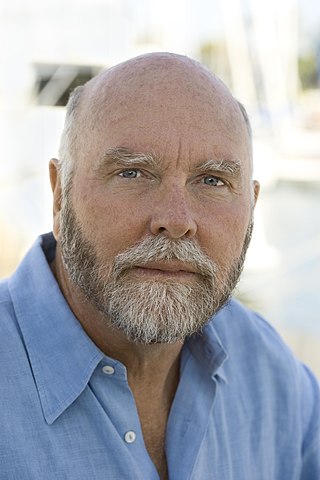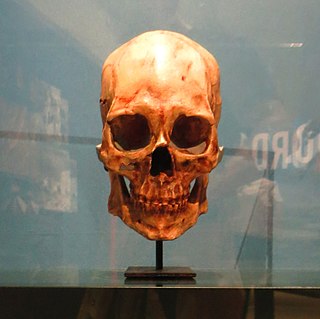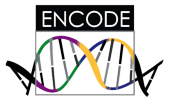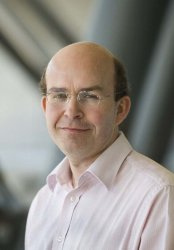Related Research Articles

John Craig Venter is an American biotechnologist and businessman. He is known for leading one of the first draft sequences of the human genome and assembled the first team to transfect a cell with a synthetic chromosome. Venter founded Celera Genomics, the Institute for Genomic Research (TIGR) and the J. Craig Venter Institute (JCVI). He was the co-founder of Human Longevity Inc. and Synthetic Genomics. He was listed on Time magazine's 2007 and 2008 Time 100 list of the most influential people in the world. In 2010, the British magazine New Statesman listed Craig Venter at 14th in the list of "The World's 50 Most Influential Figures 2010". In 2012, Venter was honored with Dan David Prize for his contribution to genome research. He was elected to the American Philosophical Society in 2013. He is a member of the USA Science and Engineering Festival's advisory board.

Kennewick Man or Ancient One was a Paleo-Indian whose skeletal remains were found washed out on a bank of the Columbia River in Kennewick, Washington, on July 28, 1996. Radiocarbon tests show the man lived about 8,900 to 9,000 years before present, making his skeleton one of the most complete ever found this old in the Americas, and thus of high scientific interest for understanding the peopling of the Americas.

Shirley Marie Tilghman, is a Canadian scholar in molecular biology and an academic administrator. She is now a professor of molecular biology and public policy and president emerita of Princeton University. In 2002, Discover magazine recognized her as one of the 50 most important women in science.

Eric Steven Lander is an American mathematician and geneticist who is a professor of biology at the Massachusetts Institute of Technology (MIT), and a professor of systems biology at Harvard Medical School. Eric Lander is founding director emeritus of the Broad Institute of MIT and Harvard.

The Encyclopedia of DNA Elements (ENCODE) is a public research project which aims "to build a comprehensive parts list of functional elements in the human genome."
T. Ryan Gregory is a Canadian evolutionary biologist and genome biologist and a Professor of the Department of Integrative Biology and the Division of Genomic Diversity within the Biodiversity Institute of Ontario at the University of Guelph in Guelph, Ontario, Canada.

The Human Genome Project (HGP) was an international scientific research project with the goal of determining the base pairs that make up human DNA, and of identifying, mapping and sequencing all of the genes of the human genome from both a physical and a functional standpoint. It started in 1990 and was completed in 2003. It remains the world's largest collaborative biological project. Planning for the project started after it was adopted in 1984 by the US government, and it officially launched in 1990. It was declared complete on April 14, 2003, and included about 92% of the genome. Level "complete genome" was achieved in May 2021, with a remaining only 0.3% bases covered by potential issues. The final gapless assembly was finished in January 2022.
Mark Bender Gerstein is an American scientist working in bioinformatics and Data Science. As of 2009, he is co-director of the Yale Computational Biology and Bioinformatics program.

Robert Bernard Darnell is an American neurooncologist and neuroscientist, founding director and former CEO of the New York Genome Center, the Robert and Harriet Heilbrunn Professor of Cancer Biology at The Rockefeller University, and an Investigator of the Howard Hughes Medical Institute. His research into rare autoimmune brain diseases led to the invention of the HITS-CLIP method to study RNA regulation, and he is developing ways to explore the regulatory portions—known as the "dark matter"—of the human genome.

Brian Kent Kobilka is an American physiologist and a recipient of the 2012 Nobel Prize in Chemistry with Robert Lefkowitz for discoveries that reveal the workings of G protein-coupled receptors. He is currently a professor in the department of Molecular and Cellular Physiology at Stanford University School of Medicine. He is also a co-founder of ConfometRx, a biotechnology company focusing on G protein-coupled receptors. He was named a member of the National Academy of Sciences in 2011.

Genetically modified animals are animals that have been genetically modified for a variety of purposes including producing drugs, enhancing yields, increasing resistance to disease, etc. The vast majority of genetically modified animals are at the research stage while the number close to entering the market remains small.
Andrea Alù is an Italian American scientist and engineer, currently Einstein Professor of Physics at The City University of New York Graduate Center. He is known for his contributions to the fields of optics, photonics, plasmonics, and acoustics, most notably in the context of metamaterials and metasurfaces. He has co-authored over 650 journal papers and 35 book chapters, and he holds 11 U.S. patents.

Timothy John Phillip Hubbard is a Professor of Bioinformatics at King's College London, Head of Genome Analysis at Genomics England and Honorary Faculty at the Wellcome Trust Sanger Institute in Cambridge, UK. From 1 March 2024, Hubbard became the director of Europe's Life Science Data Infrastructure ELIXIR.

Curtis Huttenhower is a Professor of Computational Biology and Bioinformatics in the Department of Biostatistics, School of Public Health, Harvard University.
A physician-scientist is traditionally a holder of a medical degree and a doctor of philosophy also known as an MD-PhD. Compared to other clinicians, physician-scientists invest significant time and professional effort in scientific research and spend correspondingly less time in direct clinical practice with ratios of research to clinical time ranging from 50/50 to 80/20. Physician-scientists are often employed by academic or research institutions where they drive innovation across a wide range of medical specialties and may also use their extensive training to focus their clinical practices on specialized patient populations, such as those with rare genetic diseases or cancers. Although they are a minority of both practicing physicians and active research scientists, physician-scientists are often cited as playing a critical role in translational medicine and clinical research by adapting biomedical research findings to health care applications. Over time, the term physician scientist has expanded to holders of other clinical degrees—such as nurses, dentists, and veterinarians— who are also included by the United States National Institutes of Health in its studies of the physician-scientist workforce (PSW).

Mayly Sánchez is a Venezuelan-born particle physicist who researches at Iowa State University. In 2011, she was awarded the Presidential Early Career Awards for Scientists and Engineers (PECASE), the highest honor given by the United States to scientists who are in the early stages of their research careers, for her contributions to the study of neutrinos and her work in promoting STEM fields to women. In 2013, she was named by the BBC as one of the top ten women scientists in Latin America.
Agata Smogorzewska is a Polish-born scientist. She is an associate professor at Rockefeller University, heading the Laboratory of Genome Maintenance. Her work primarily focuses on DNA interstrand crosslink repair and the diseases resulting from deficiencies in this repair pathway, including Fanconi anemia and karyomegalic interstitial nephritis.

Rodney Dewayne Priestley is an American chemical engineer and professor at Princeton University. His research considers the phase transitions of polymers and their application in electronic devices and healthcare. In 2020 he was made the Princeton University Vice Dean of Innovation. He was named dean of The Graduate School effective June 1, 2022.

Harmit Singh Malik is an Indian American evolutionary biologist who is a professor and associate director at the Fred Hutchinson Cancer Research Center. He was awarded the 2022 Genetics Society of America Edward Novitski Prize.
Mónica Medina is a professor of organismal biology at the Pennsylvania State University. She is known for environmental activism, such as fighting to protect Varadero Reef, and her research on the ecology and evolution of symbiosis by studying the relationships between cnidarian, endosymbiotic dinoflagellates, and other microbes.
References
- ↑ "AGBT Meet the Bloggers". Archived from the original on 2014-01-09. Retrieved 2014-01-09.
- ↑ Margulies, EH et al. (2003) Identification and characterization of multi-species conserved sequences, Genome Research 13(12), 2507-2518.
- ↑ Gottsch, JD et al. (2003) Serial analysis of gene expression in the corneal endothelium of Fuchs dystrophy, Investigative Ophthalmology & Visual Science 44(2), 594-599.
- ↑ "White House Announces 2007 Awards for Early Career Scientists and Engineers". White House archives of George W. Bush. 2008-12-19. Retrieved 2011-07-04.